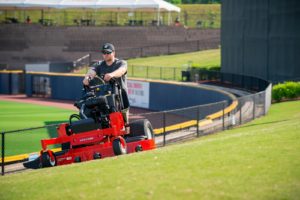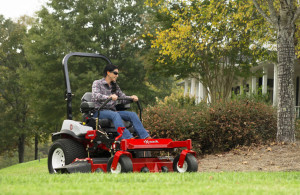 With temperatures soaring well above 100 degrees and drought advisories in effect across the country, summertime lawn care can be a challenging task. However, maintaining a healthy lawn is not impossible—especially if you have the right tools for the job and know how to manage turf in the heat of summer.
With temperatures soaring well above 100 degrees and drought advisories in effect across the country, summertime lawn care can be a challenging task. However, maintaining a healthy lawn is not impossible—especially if you have the right tools for the job and know how to manage turf in the heat of summer.
From changing your mowing times to adjusting your mower to meet your lawn’s demands, here are a few tips for taking care of cool-weather grasses in seasonally high temperatures.
Set Your Mower Blades Higher: Longer grass tends to hold moisture better than short grass, especially in areas of high sun exposure. Instead of setting your lawn mower blades to remove the top 1/3 of the blade, raise it even higher. Although you’ll have to mow more often to keep your yard looking neat and trim, the higher cut will help the grass be less susceptible to stress.
Change Your Mowing Time: In order to minimize the stress on your lawn, plan to mow either early in the morning or late in the evening (provided your neighbors won’t mind). You might also want to mow after a rainfall or good day of watering. This way, you can avoid inadvertently causing stress to the grass from the combination of shorter grass and midday heat. You should also make sure your blades are sharp and working well. Dull mower blades can add an unnecessary strain on the grass, as they can cause tearing.
Mulch Grass Clippings: Instead of bagging or blowing the grass after you mow, mulch the clippings back into the lawn to become part of the life cycle. These nutrient-rich clippings provide moisture and other necessary nutrients to help keep your lawn healthy.
Avoid Foot Traffic: Keep your kids and pets off of any grass that’s struggling under stress. The less traffic you allow on your lawn, the better it will look overall.
Research Grass Varieties: Cool-season grasses include varieties like fescue, bluegrass, and rye. Warm-season grasses include zoysia, St. Augustine, centipede, and Bermuda. Cool-season grasses tend to fade a lot faster once temperatures move up over 60 degrees, and are much more likely to fall into a dormant phase. Know what’s in your yard and tailor a care plan accordingly.
Let the Grass Go Dormant: A dry, brown, and dusty yard isn’t necessarily dead. Many varieties of grass are designed to “go to sleep” when weather conditions are especially hot or dry. This state of dormancy allows the grass to go up to two months without water. Yes, it won’t look nice, but you don’t need to tear up the lawn and start all over next year. As soon as temperatures drop and rainfall picks back up, your lawn will start return to its former glory.
Avoid fertilizing during the dormancy stage and high heat. Because your grass is taking a break until cooler temperatures prevail, it’s not likely to soak in the nutrients in the right proportions. And don’t aerate during long hot, dry spells, as this can create additional stress to the turf.
Once temperatures cool off, water your lawn deeply and infrequently to rehydrate the turf. Proper soil moisture will also promote healthy root growth. Proper rehydration will help bring your lawn back lush and green through the fall








